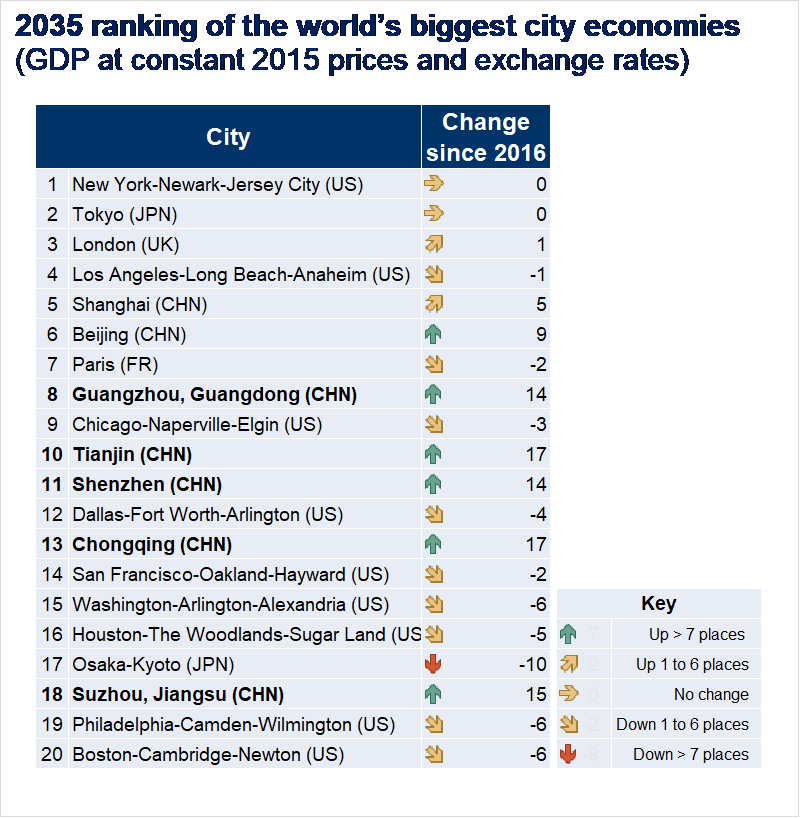Ungated Post | 22 Dec 2017
Urban power shifts east as Asian cities’ economies burgeon

China’s cities’ GDP to double, and will outstrip Europe’s and North America’s by 2035. But New York, Tokyo, London and LA to stay as world’s urban superpowers as Shanghai closes in.
The world is ever more urban. The top 780 global cities already produce almost 60 per cent of all world economic activity, and they are set grow in importance as urbanisation continues.
By 2035, these cities will be home to almost half a billion additional people with their GDP rising by $32 trillion (constant 2015 prices and exchange rates).
In our latest annual Global Cities report, we forecast significant growth disparities between cities around the globe over the coming decades to 2035 and predict far-reaching changes in the world’s urban order, with the balance of urban economic power shifting further east as a result.
By 2035, we project that Asian cities will account for almost half of global city activity, overtaking the combined activity of European and North American cities in just over a decade.
The GDP of the 150 Chinese cities covered in this study already exceeds that of the largest European cities and will overtake North America’s cities by 2022. And by 2035, the aggregate GDP of Chinese cities is forecast to more than double from almost $11 trillion today to over $25 trillion (measured in 2015 prices and exchange rates).
However, we still expect most of today’s biggest city superpowers to retain their positions as the largest cities in terms of GDP in 2035, led by New York, Tokyo, London and Los Angeles. Paris, though, is expected to drop out of the top 5, replaced by Shanghai. It will be joined in the top 10 cities worldwide by three other rapidly growing Chinese cities: Beijing, Guangzhou and Tianjin.

And we expect cities’ share of global activity to rise further. By 2035, the global 780 cities will be home to almost half a billion additional people. There will be 264 million more people in employment in these centres.As the world’s economic landscape is evolving, cities are in the forefront of change, and now account for more than half the world’s disposable income and generating almost 60 percent of global economic activity.
Asian cities will be at the forefront of this shift, led by China’s. With its cities economic might set to overtake that of the main American and European cities the shift is striking – just ten years ago the combined GDP of European and North American cities was twice the size of Asian cities.
Chinese cities alone will account for almost half of the increase in global city GDP and will represent around a third of total urban GDP by 2035. By contrast, the combined output of the 58 North American cities covered in our analysis will rise by US$5.3 trillion, followed by non-Chinese Asian cities (US$4.7 trillion) and then European cities (US$3.4 trillion).
Today, there are 18 Chinese cities in the world’s top 100 ranked by absolute size of GDP and by 2035 there will be 15 more, with Dongguan, Jinan and Xian climbing the rankings. Four non-Chinese Asian centres also enter the top 100: Mumbai, Delhi, Bangalore and Kuala Lumpur.
These new entrants come at the expense of a number of cities in the West. The number of North American cities in the top 100 will fall by 11 to 27 in 2035, with cities such as Pittsburgh, Indianapolis and Vancouver failing to maintain top 100 status.
In Europe, we expect seven cities to drop out of the top 100, leaving just 14. Those falling out of the top 100 from Europe include capitals cities (Amsterdam, Brussels, Copenhagen and Vienna), as well as Barcelona, Frankfurt and Hamburg.
Tags:
You may be interested in

Post
Oxford Economics Expands Regional Presence with the Launch of Chinese Website
Over the past six years we've maintained the unique modelling and analysis that clients and the media have come to rely on from BIS Shrapnel while incorporating Oxford Economics' rigorous global modelling and analytical framework to complement it," said David Walker, Director, Oxford Economics Australia.
Find Out More
Post
Oxford Economics Introduces Proprietary Data Service
Oxford Economics is excited to enrich its suite of asset management solutions with the introduction of the Proprietary Data Service.
Find Out More
Post
Australia: RBA hike by another 25 bps as the fight against inflation continues
The RBA has raised its cash rate target by a further 25 basis points, taking it to 4.1%. Although inflation has peaked, the RBA board is still clearly uncomfortable with its brisk pace.
Find Out More